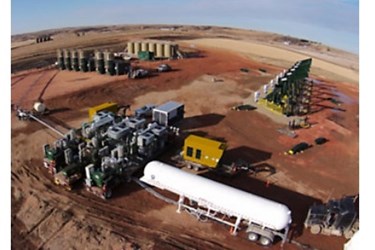Reduction In Gas Flaring Earns Cat Customer A World Bank Excellence Award

By capturing, using and selling flare gas that otherwise would be released into the environment, Hess Corporation is reinforcing its commitment to sustainable operations—and the World Bank is taking notice.
In September, in Khanty-Mansiysk, Russia, Caterpillar Oil & Gas accepted an award of excellence from the World Bank Global Gas Flaring Reduction Partnership (GGFR) on behalf of Hess and GTUIT, a manufacturer of mobile gas treatment systems in which Caterpillar is a minority shareholder. Hess is using 15 of GTUIT’s mobile gas capture and natural gas extraction units at well sites in North Dakota’s Bakken oilfield.
“This is a reaffirmation of our commitment to reduce flaring in the Bakken and throughout our global operations,” says Alex Sagebien, vice president of environment, health and safety for Hess. “We are appreciative of our partners on this project and for the international recognition from the World Bank for the Excellence Award for flare reduction at our North Dakota operations."
To date, GTUIT’s innovative equipment has helped Hess recover nearly 8 million gallons of natural gas liquids, prevent 17,100 tons of volatile organic compounds from being flared and keep 55,900 tons of carbon dioxide from entering the atmosphere.
“GTUIT’s technology reduces the flaring of gas associated with oil production, while producing conditioned gas that’s suitable for use in Cat® engines,” says Stephen Percy, business development manager for Caterpillar Oil & Gas. “That provides significant economic benefits, as it’s essentially ‘free’ fuel that companies like Hess can use instead of diesel—or they can sell it on the open market. There are also significant environmental benefits in terms of reduced emissions.”
GTUIT’s mobile units, which are about the size of a semi-trailer and easily connect to an engine, are ideal for remote locations like the Bakken, where oil and gas infrastructure hasn’t yet caught up with the pace of recently increased production.
“Companies can use GTUIT’s units for a year or two until they put in a gas pipeline,” Percy says. “They’re small in size, cost-competitive, scalable and mobile, which makes them perfect for use in small oilfields.”
They’re also addressing the trend on many oil and gas sites toward the use of 100% gas engines or dual-fuel engines, which burn a mixture of natural gas and diesel.
“Because the associated gas or field gas coming out of a well may be too ‘hot,’ meaning its energy content is too high, the fuel has to be conditioned before it can run in the engine,” Percy says. “GTUIT’s technology works with Cat engines so they can operate on wellhead gas with no loss of performance.”
A public-private initiative made up of oil companies, government bodies and other institutions, GGFR’s goal is to increase the use of natural gas in oil production by helping remove technical and regulatory barriers to flaring reduction. The organization also conducts research, shares best practices and develops country-specific gas flaring reduction programs.
“This award validates our investment in GTUIT as part of Caterpillar’s commitment to sustainability,” says Dave Dunlevy, Caterpillar Oil & Gas managing director. “GTUIT’s innovative systems for flare gas treatment and conditioning, combined with Caterpillar’s gas or dual-fuel engines and generator sets, can offer significant financial and environmental benefits to operators in drilling, well service and production applications, reducing the amount of gas flared while at the same time reducing the use of diesel fuel.”
“We are proud to collaborate with world-class companies like Hess and Caterpillar. Hess recognized prior to state regulation being enacted that well site flare capture was the right thing to do, both environmentally, socially and financially, ” says Brian Cebull, president and CEO of GTUIT. “Our relationship with Hess and Caterpillar has allowed us to expand our presence and recognition globally.”
Source: Caterpillar
